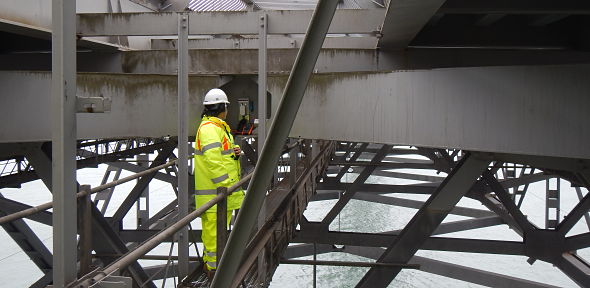Submitted by L. Millard on Mon, 11/01/2016 - 21:04
A CSIC-developed energy harvester has been tested on the Forth Road Bridge in Scotland where, powered only by traffic and wind induced bridge vibrations, it was demonstrated successfully powering a wireless mote which transmitted data to a receiver mote.

Image: Yu Jia installing the energy harvester at the Forth Road Bridge
Designed by CSIC’s Dr Yu Jia, Dr Ashwin Seshia and the Sensors and Data Collection team, the patented low-cost, wireless, battery-free energy harvesting device was trialled at the live site in April 2015 where it was deployed for part of a day at a number of locations under the deck of the Forth Road Bridge.
The vibration-powered wireless monitoring technology has the potential to enable maintenance free, autonomous measurement of the behaviour of key structural elements of infrastructure, even in the most difficult-to-reach areas, giving the owner a far greater understanding of the actual capacity and level of safety of an asset.
The new vibration harvesting energy technology developed by CSIC is a world-class innovation with several large potential markets
The results of the Forth Road Bridge trial, which demonstrated that the technology works in live conditions, were presented at the world’s premier academic conference on micro and nanotechnology for power and energy applications, PowerMEMS 2015, in Cambridge (MA, USA), at the close of last year.
“The paper was well received at the conference and was one of only a few academic contributions that has demonstrated the operation of the technology in a real environment,” said Yu.
“Our macro-Vibration Energy Harvesting (VEH) prototype has demonstrated the potential to generate substantially more power than devices based on more conventional approaches to vibration energy harvesting and could provide a convenient, self-sustaining on-board power solution to complement emerging wireless sensor technologies – the smarter power backbone to the ever-growing wireless infrastructure.”
The conventional resonant-approaches to scavenge kinetic energy are typically confined to narrow and single-band frequencies. CSIC’s vibration energy harvesting device combines both direct resonance and parametric resonance in order to enhance the power responsiveness towards more efficient harnessing of real-world ambient vibration.
In the field-site, the packaged electromagnetic harvester designed to operate in both of these resonant regimes, with an operational volume of ~126 cm3, was capable of recovering in excess of 1 mW average raw AC power from the traffic and wind-induced vibrations in the lateral bracing structures underneath the bridge deck. The harvester was integrated off-board with a power conditioning circuit and a wireless mote. Duty-cycled wireless transmissions from the vibration-powered mote were successfully sustained by the recovered ambient energy.
“This limited duration field test provides the initial validation for realising vibration-powered wireless structural health monitoring systems in real world infrastructure, where the vibration profile is both broadband and intermittent,” said Yu.
“We now plan to work on enhancing the robustness of the harvester prototype, improving the efficiency of the power conditioning circuitry, further minimising the power requirement of the WSN mote and incorporating sensor systems onto the vibration powered mote in order to realise long term deployment trials at field-sites in the near future.”
A spin-out company, 8Power, is being formed to commercialise the technology. Robert Trezona, from IP Group plc, a venture capital organisation for British technology companies, said: “The new vibration harvesting energy technology developed by CSIC is a world-class innovation with several large potential markets.”
A paper detailing CSIC’s macro-VEH prototype and field trial, titled A vibration powered wireless mote on the Forth Road Bridge, has been published in the Journal of Physics: Conference Series.
